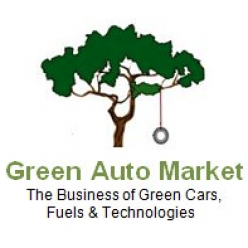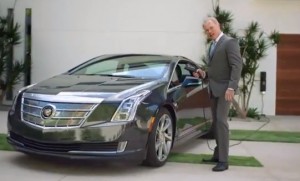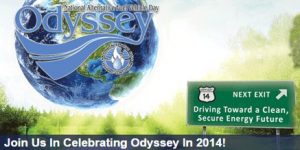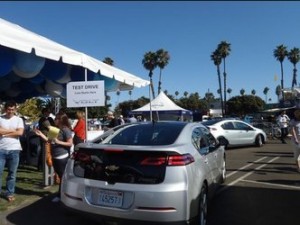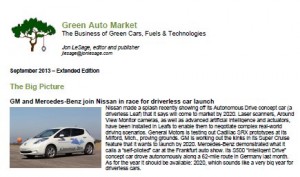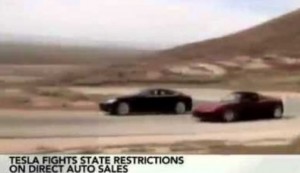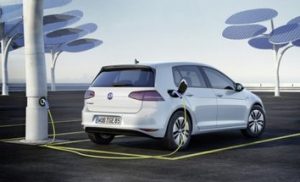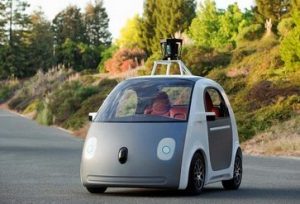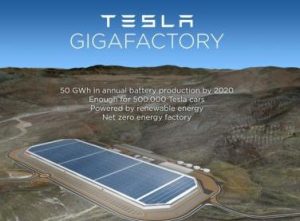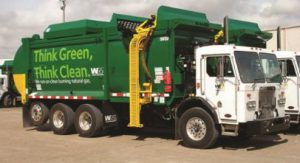by Jon LeSage, editor and publisher, Green Auto Market
Here’s my take on the 10 most significant and interesting occurrences during the past week…….
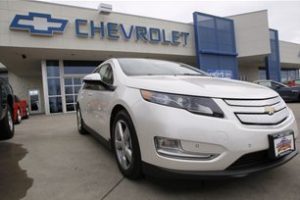 GM’s new green dealer program: For GM dealers looking to attract car shoppers who are searching for fuel-efficient vehicles from environmentally responsible companies, pay attention to the Green Dealer Recognition Program. Participating dealers in the Chevrolet, Buick, GMC, and Cadillac brands in the US are participating in the program to earn the credential. That comes from energy reduction, renewable energy use, water conservation, recycling, community outreach, and setting up onsite nature habitats, according to General Motors. GM has been recognized for its corporate sustainability initiatives, and this program ties into goals to reduce its environmental footprint and green its supply chain. Dealers are joining the program voluntarily and are encouraged to build a network for sharing best practices.
GM’s new green dealer program: For GM dealers looking to attract car shoppers who are searching for fuel-efficient vehicles from environmentally responsible companies, pay attention to the Green Dealer Recognition Program. Participating dealers in the Chevrolet, Buick, GMC, and Cadillac brands in the US are participating in the program to earn the credential. That comes from energy reduction, renewable energy use, water conservation, recycling, community outreach, and setting up onsite nature habitats, according to General Motors. GM has been recognized for its corporate sustainability initiatives, and this program ties into goals to reduce its environmental footprint and green its supply chain. Dealers are joining the program voluntarily and are encouraged to build a network for sharing best practices.- More clean transportation funding: US Energy Secretary Ernest Moniz last week announced that $55 million will be available to develop and deploy vehicle technologies that strengthen the clean energy economy. Funded projects will include advanced batteries and electric drive research and development, lightweight materials, advanced combustion engines, and alternative fuel technologies. The Dept. of Energy will support projects to reduce the price and improve the efficiency of electric vehicles, alternative fuel, and conventional vehicles. About that time, California Energy Commission (CEC) announced granting about $12 million through its Alternative and Renewable Fuel and Vehicle Technology Program. About $11.2 million will go to natural gas vehicles and will be administered through University of California, Irvine. In a separate announcement, the Luskin Center at University of California, Los Angeles, said that its’ won two project grants from CEC. The first project through Luskin Center’s Southern California Plug-In Electric Vehicles Readiness Plan will take on bringing more charging stations to multi-unit dwellings. The second project teams with UC San Diego, San Diego Gas and Electric and others to manage solar energy in tandem with workplace electric vehicle batteries.
- Green Car Journal presented its second round of green vehicle awards at the Washington Auto Show. The Jeep Grand Cherokee EcoDiesel won Green SUV of the Year, the BMW i8 took Luxury Green Car, and the Ford F-150 won Green Car Technology for its new design including using aluminum reducing the truck’s weight by about 700 pounds. The i8 beat out the Tesla Model S, Cadillac ELR, Porsche Panamera S E-Hybrid, and the Audi A8TDI. In a separate competition, the 2015 Ford F-150 took the top prize in the Automotive Science Group’s (ASG) fourth annual life-cycle study. According to ASG, the F-150 holds the smallest life-cycle carbon footprint and lowest cost of ownership of any full-size truck in the North American market today.
- Last week, Ford opened the doors of its new Research and Innovation Center (RIC) in Palo Alto, Calif., aimed at technologies and experiments in connectivity, mobility, autonomous vehicles, customer experience, and data analytics. The automaker has formed an alliance with Stanford University, creating the Fusion Hybrid Autonomous Research Vehicle for testing by engineers. Dragos Maciuca, an experienced engineer from Apple, has joined Ford to serve as senior technical leader at RIC Palo Alto; additional hiring plans will support Ford in meeting its goal of having one of the largest automotive research teams in Silicon Valley.
- Renewable energy expert Craig Shields just had his fourth book published, Bullish on Renewable Energy: Fourteen Reasons that Clean Energy Investors Can’t Lose. While his first three books featured interviews with experts in science, the regulatory environment and business realities, this book comes from original writing and is surprisingly optimistic: “The battle has been won. The forces of market economics are in the process of changing so rapidly that planet Earth is headed for a clean energy future far faster than anyone could have predicted.”
- Connecticut may allow sales of Tesla vehicles: Connecticut originally rejected Tesla stores as a violation of its law banning automakers from operating their own dealerships, but that may be changing. If the law is altered, Connecticut will join Massachusetts, Minnesota, New York, Nevada, and Pennsylvania in legalizing Tesla direct sales (sometimes with restrictions). Tesla has been banned from Arizona, Michigan, Texas, and Virginia; and is limited to one store in Colorado, and was forced to close its two stores in New Jersey last year.
- NGVAmerica just released a study making a strong case for natural gas vehicles. The study looked at world crude oil prices on an historical perspective along with energy forecasts. Natural gas has been much more stable and low-priced than gasoline and diesel for decades. That makes a compelling case for bringing in natural gas vehicles by commercial and government fleets; transportation costs represent a large share of their budgets, so the need to predictably plan fleet acquisitions and fueling is critical.
- More electric car news: Porsche will roll out the long-anticipated Pajun sedan, but only as an electric model. Plans have been dropped to roll out gasoline and diesel versions. The sporty sedan will go head-to-head with the Tesla Model S. Chevrolet will be bringing its Spark EV to Maryland this spring, its first East Coast entry and third state overall – following California and Oregon in 2013. Maryland is a “strong commuter market” with relatively widespread charging infrastructure, General Motors said in a statement.
- Goodbye nuclear, hello hydrogen: Toyota will be spending 45.2 billion yen ($385 million) on fuel cell vehicle subsidies and hydrogen stations before the 2020 Olympics in Tokyo. It’s part of Prime Minister Shinzo Abe’s strategy to move the nation away from reliance on nuclear power following its March 2011 disaster at the Fukushima nuclear power plant. Japan’s capital will build 35 stations to fuel hydrogen-based fuel cell vehicles and is in negotiations with Toyota Motor Corp. and Honda Motor Co. to put 6,000 hydrogen cars on its roads by 2020.
- BMW and Volkswagen have formed an alliance with ChargePoint to build 100 DC fast charger stations along bi-coastal routes. The West Coast route will stretch from Portland to San Diego, while the East Coast route will run from Boston to Washington, D.C. The chargers will be spaced at intervals of 50 miles or less, to alleviate driver range anxiety.
